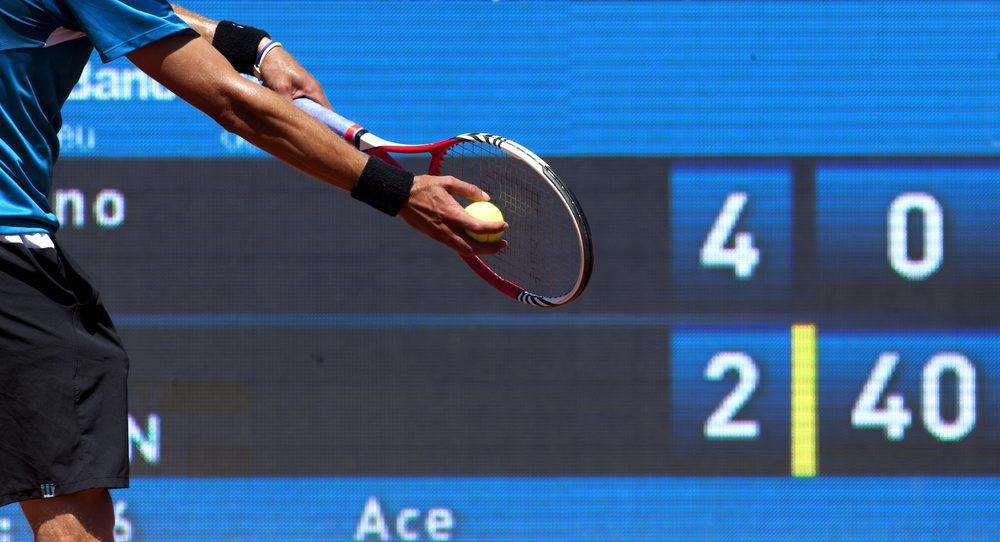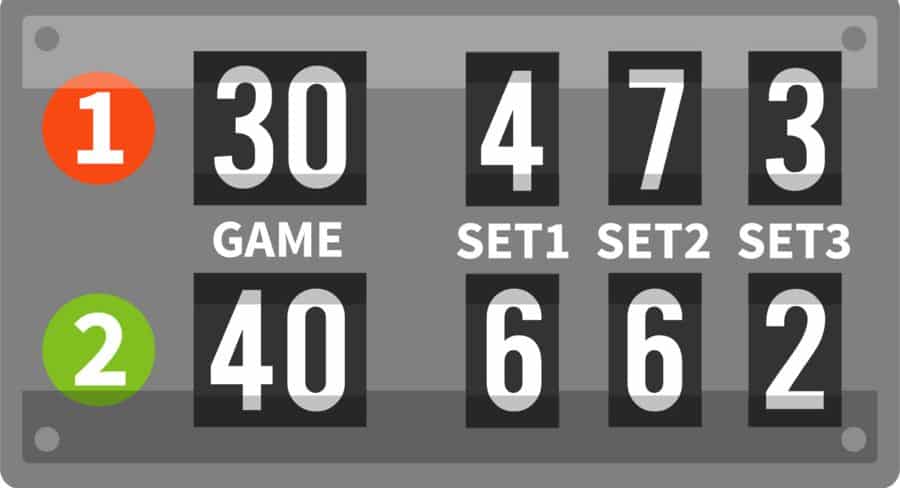Tennis Scoring: How To Keep Score In Tennis

When a person first learns about the scoring system in tennis, it can be one of the most confusing aspects of the sport. There is indeed nothing quite like tennis scoring, but it becomes pretty simple once people get the hang of the terminology.
Below, we take a look at the different parts of a tennis match, and how the scoring links together. Some of these terms are not used in other sports at all, but once a person gets the hang of it, keeping tennis score becomes second nature.
Understanding Point, Game, Set & Match

At the end of any professional match, the chair umpire will call out “game, set, and match” for the winning player. They are said in that order for a particular reason, as players need to win six games to take the set. Then, they need to win a certain amount of sets to win the match (usually two or three). Of course, it all starts with a point, which starts as soon as the server hits a ball in (or if a server misses two serves and double-faults).
At all levels of tennis following standard rules, a player must win six games to take the set. Then, a player needs to win either two sets if it is a best-of-three, or three sets if it is a best-of-five. Most best-of-five matches have gone away, except, notably, for the men at Grand Slam events.
- 1 Set is played first to 6 games
- If you win 2 sets=You win the match (Only exception Grand Slam events)
How Points Lead To Games

Every single time a player serves, that is the start of a point. It’s a race to four points, but a player must win by two. What makes scoring a bit confusing is that instead of going one, two, three, four, the scoring goes 15, 30, 40, and game.
Here is a breakdown of how the different numbers work
- 1 Point=15
- 2 Point=30
- 3 Points=40
- 4 Points=Game
The serving side is the main person in charge of keeping score. They also call out the score right before serving each time, with their score going first. That means if they won the first point, the score is 15-0. If the server has won two points, but the opponent has won three, the score is 30-40.
If a game reaches 40-40, the terminology for that is deuce. Both players have won three points, and they are trying to win consecutive points to take the game. If the server when is the next point, it is their advantage. If they lose the next point, it’s the opponent’s advantage.
- When the score is 40-40, something called “deuce” occur
- If player A wins the next point the score is AD-40 (AD=Advantage)
- If player A wins another point, they win the game
- If the score is AD-40 and player B wins the next point, the score goes back to 40-40 (deuce)
At the recreational level, the proper score call is saying “ad-in” for the server’s lead, and “ad-out” for the receiver’s lead. At the pro level, the chair umpire will usually call out the players name who has the advantage.
Once a player has reached four points, or has won by two after reaching deuce (40-40), they win the game. The two sides alternate service, and switch sides on the court after all odd games.
How Games Lead To Sets
A standard set is a race to six games. Players can win a game as the server or the receiver. Just like with games, the only caveat is that a player must win by two in order to take the set.
This starts to become an issue when the score is 5-5. No player will be able to win the set in just six games. When a set reaches the score, there are usually just two games left before a tiebreak opportunity. If a player wins both of those games, they take the set 7-5. If the set is 6-6, a tiebreak starts.
- You need to win with at least 2 games to win a set (5-6 is not a valid score)
- If the score is 6-6 in games, something called tiebreak will occur
- Whoever wins the tiebreak, wins the set (7-6)
A tiebreak normally goes to seven points, with each player serving twice before alternating. It is a race to the target score, and players must win by two for them to take the set. Tiebreakers are a great way to speed up the game, because the other alternative is to continue playing until someone wins two more games in the opponent.
- Tiebreaks are played first to 7 points
- It’s played until a player wins with at least 2 points
This famously happened at Wimbledon between John Isner and Nicholas Mahut. They battled in the fifth set, with Isner winning 70-68 after eventually finding a way to break serve.
How Sets Lead To A Match
Just about every standard tennis match is a best-of-three format in today’s game. Not only does it save a lot of time, but players can stay a lot fresher knowing that they can only possibly go three sets.
The lone exception at the professional level is at the Grand Slam events. The men will play best-of-five sets, which can lead to matches that last four or five hours long fairly regularly. There used to be more best-of-five sets, but it became a logistical nightmare to schedule with so many variables changing the amount of time spent on court.
At recreational levels, some people will speed up the game even more by opting for a third set tiebreak instead of playing a full set. If each side wins a set, a tiebreaker to seven or ten is used instead of playing a full set. Some people don’t like the variables this presents, while others love the idea of not dragging out matches too much.
Tennis Terminology To Know

Being around a tennis match as someone who doesn’t know how to score can almost seem like they are talking a different language. There are a lot of specific tennis terms that aren’t used in other sports, and that frustrates some people early on.
A few of the most commonly used terms that are specific for tennis are listed below. Think of this as a bit of a cheat sheet if someone says something that doesn’t seem familiar.
Point
Each serve starts a new point. At the beginning of a game, the score is love-love (0-0). Points are 0-15-30-40-game.
Game
A player must win four points to win the game, and have at least a 2-point advantage. Otherwise, the game goes to deuce if tied, and to advantage once a player takes a 1-point lead.
Set
The first player to win six games, with a two-game advantage or more, wins the set.
Match
A player wins either two or three sets, depending on the format of the match.
All
All is just another way to say both in tennis. This word “all” is used for calling out game scores, saying 15-all instead of 15-15. If the match is tied at 1-1 with sets, people use the term in this scenario as well.
Love
Love is another way to say zero in tennis. If the score is ‘4-0,” it would be announced as “four love.” People believe that this started because the number “0” looks like an egg, and the egg translates to “l’œuf” in French.
Deuce side
The deuce side of the court is when the server is on the right. It is given that name because the score can only be deuce on that side in a close game.
Ad side
This is the left side of the court. When a game is close, a player can only win the game if they win a point on the ad side with a lead.
First serve
Every point starts with a serve, and a server has two opportunities to get it in. The first serve is generally hit harder, since a server can take more risks.
Second serve
A second serve happens only if the first serve goes out. Generally speaking, this serve travels at a slower pace, but with more spin.
Let
If the first serve hits the net, but still falls into the service box, a let is called. This allows for the serve to be hit again, without any penalties. A let can also happen if a ball from another court rolls into play, debris is present, and other distractions.
If you want to read more about all the rules involved in the scoring system, check out this post.






